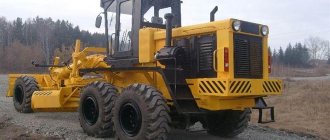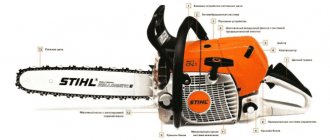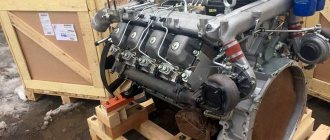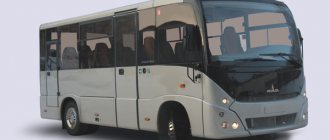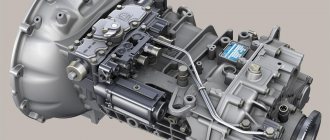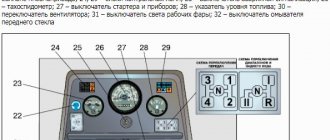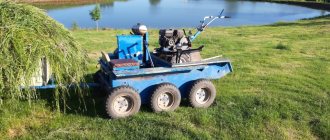Home / Tips
The MAZ-103 city bus was developed as an alternative to similar equipment produced in Hungary, Russia and Ukraine. The first model produced by the Minsk Automobile Plant rolled off the assembly line in 1996. The low floor position and the absence of steps make it easier for passengers to board and disembark at stops. The car combines quality, comfort and affordable cost.
It is operated in Belarus, Russia, European and Asian countries.
As a basis for the product, engineers took the best examples of urban transport that were used at that time, adapting it to low-quality roads.
The MAZ-103-485 bus has the following technical characteristics:
- length - 1200 cm;
- width - 250 cm;
- height - 250 cm;
- weight without refueling - 18000 kg;
- wheelbase front and rear - 205 and 185 cm;
- maximum load on the front and rear axles - 6500 and 1500 kg;
- turning radius - 1125 cm;
- floor height - 34 cm;
- passage between seats - 80 cm;
- number of seats - 25;
- passenger capacity - 100 people;
- maximum speed - 110 km/h;
- wheels - disc 8.25×22.5 with tires 11 70R22.5;
- suspension - independent pneumatic with telescopic shock absorbers.
A special feature of the MAZ-103-075 bus is the rear location of the power plant. Thanks to this solution, it was possible to lower the vehicle's landing and make it more stable when cornering and strong crosswinds.
Engine Description:
- type - diesel;
- brand - MMZ D-260.5;
- power - 230 hp;
- working volume - 6.4 l;
- fuel consumption per 100 km in urban mode - 26 l;
- gearbox - mechanical;
- cooling system - forced water.
The power plant is fixed to the frame using four supports with shock absorbers. Due to this, vibration in the cabin is practically not felt. The later model of the MAZ-105 articulated bus is equipped with an OM906LA engine with Euro-5 environmental class and a ZF automatic transmission.
Equipment
The base model is equipped from the factory with two rows of seats. There are double chairs on the left and single chairs on the right. The all-welded frame is resistant to vertical and torsional loads. Cars of recent years of production are equipped with Mogilev single-chamber double-glazed windows with ultraviolet-reflecting coating. Thanks to this, a comfortable temperature is maintained in the cabin in the summer.
The MAZ-105 bus is equipped with the following options:
- automatic shock absorbers that level the body when there is a difference in load and when driving on an inclined road;
- tinted windows that block solar radiation;
- plastic seats resistant to impacts and sharp objects;
- ceiling fans that remove polluted air from the cabin when idling in traffic jams;
- LED board broadcasting information about the route and advertisements;
- plastic handles located at different heights, convenient for tall and short passengers;
- automatic fire extinguishing system, activated without human intervention;
- interior heater with thermal barrier on the doors.
The manufacturer produces school buses with two rows of seats and a reinforced frame. For the needs of public utilities, mobile toilets are produced, which go to crowded places on city streets and squares.
Comfortable and spacious passenger bus
There is no need to talk about the advantages of the lower sex. Disembarkation and pick-up of passengers is done more quickly and conveniently, and this, in turn, significantly reduces travel time along the route. It must be said that the MAZ designer was unable to fully reproduce the design of the German Neoplan. Due to the fact that the engine had impressive dimensions and was located in the rear of the cabin, the floor there was raised. Stepless entry remains at the front and middle doors, where the floor level reaches 360 mm. In the rear door area, the floor height was increased to 580 mm, which required two steps.
In general, the MAZ 103 bus turned out to be comfortable, roomy and safe and quickly gained popularity not only in its homeland, but also abroad. In addition, the transport was distinguished by good maneuverability, which allowed it to feel more confident in dense city traffic.
The rear axle, which is the drive axle, has a bevel gear offset from the transverse axis and is made according to the classical design. The MAZ-103 is presented in several versions: in addition to the main model, the manufacturer also offers a modification for suburban passenger transportation - MAZ-103S. The differences are the number of seats increased to 45 and the absence of a rear door. The base model has several trim levels, differing in passenger capacity and number of seats. The number of passengers carried is 90 - 100 people, and the number of seats is 21 - 28.
As for the internal structure of the MAZ 103 bus, the arrangement of passenger seats is made according to a three-row design: double on the left side, single on the right. Opposite the middle door there is a spacious storage area. The driver's cabin is quite spacious, with convenient layout of controls. Although the dashboard is a bit angular compared to Western bus models, the information on it is easy to read.
Model range of MAZ buses, characteristics and photos
The Minsk Automobile Plant celebrated its 75th anniversary in August, and a new product for the anniversary was a spectacular city bus - MAZ-303.
All three doors have the same width - convenient for both passengers and operators
Interesting looking car! With its two-tone color and the characteristic shape of the diamond-shaped break in the roof line, it is reminiscent of its European counterparts - for example, the Polish Solaris. However, Minsk residents explain that the silhouette of the roof symbolizes the image of a bison, and at the beginning of the production of MAZ buses, some batches were painted green and white.
One-and-a-half seats on the starboard side made it possible to significantly expand the central aisle
However, the main users of buses, passengers, evaluate not so much the design as the interior layout.
The right wheel arch - the weak point of low-floor vehicles - has become more functional
The interior of the new MAZ is well designed: the interior is spacious, and 95 people can fit here. There are 26 seats. The floor is flat along its entire length, and thanks to the extended wheelbase, additional areas have been freed up, making it possible to place “social” seats on them - seats that do not need to be climbed onto. Space for a wheelchair may also be provided.
Unlike previous generations, the handrail installation scheme has been redesigned, the air conditioning and heating systems have been modernized, and the LED interior lighting now changes depending on the time of day. Each pair of seats also has ports for charging gadgets.
The design of the cabin has also changed: thanks to the raised upper edge of the windshield and a high podium, visibility has improved, the driver's legroom has increased, and an abundance of niches and drawers allows you to place small items, documents and personal belongings.
The instrument panel is now adjustable along with the steering wheel, like in European buses or new LiAZs; the buttons are located more logically on the panel itself.
The layout of the engine compartment is very tight, but there are no high “humps” on the roof
Now - about technical changes in the design. For the manufacture of the frame, pipes made of corrosion-resistant steel were used, the body is also assembled from materials that are not subject to corrosion, and its external panels can be replaced element by element.
Six electric fans save space with increased efficiency
Mercedes 7.7 engine with 299 hp. located in a separate compartment, the dimensions of which are even smaller than those of the previous generation buses (although a lot of space is needed to accommodate all engine systems of the Euro-6 environmental class). The exhaust system remained at the bottom, which made it possible to maintain the overall height of the new product within 3.1 m - a parameter that is relevant for old parks with low entrance gates and ceilings. And the 250-liter fuel tank, made of plastic, received a very complex shape - and at the same time saved additional space for passengers. As for the rest of the units, the bus is equipped with a six-speed ZF automatic transmission, the same brand is equipped with independent suspension elements at the front and rear axle.
Taking care of the driver - adding washer fluid through the hose, and no need to fuss with the canister
The twelve-meter MAZ-303 is the first-born of a new family of passenger cars. In the future, it will be represented by various versions of city buses - from a short 9-meter car to an 18.5-meter accordion. Suburban versions have not been forgotten either - a 13.5-meter car with increased passenger capacity is planned. Belarusians are also preparing to introduce a new apron bus for airports in the near future.
The route indicator is a separate element, and the windshield can be made of two halves
And on the basis of the new generation, the first electric bus with the MAZ emblem will be built: it is stated that the experience of operating electric buses in Moscow and Minsk was taken into account when designing it.
From the cheapest to the most expensive: engine options vary
The technical characteristics of the MAZ 103, along with modern design and a high degree of comfort, were another reason to be proud of the new bus. The very first models of passenger transport were equipped with YaMZ and MMZ engines, but already during operation it became clear that Yaroslavl engines were absolutely not suitable for it. They were not powerful enough, but they were noisy, large, heavy and poorly compatible with the gearbox proposed by the designers.
The engines of the Minsk Motor Plant, with a power of 320 hp, at that time turned out to be the best option, and for the first few years of production, all low-floor vehicles were equipped with them. Until 2004, Renault engines were also installed on MAZ 103 buses. More reliable and powerful (250 hp), they inspired more confidence among drivers.
Currently, MAZ offers several engine options, including Mercedes-Benz (231 hp) and Deutz (237 hp). Units from well-known foreign manufacturers are highly reliable and comply with stricter environmental standards.
If we talk about the gearbox, the bus was initially equipped with a 6-speed transmission of its own production, but its incompatibility with a number of engines forced the designers to look for other options and most buses began to be equipped with a 5-speed Praga gearbox. Recently, MAZ has been offering buses with a manual transmission manufactured by ZF or hydromechanical company Voith.
Long-term experience in operating this model has shown that the transport is quite reliable, can handle significant loads, and the possibility of breakdowns is minimized. If repairs are necessary, all spare parts for MAZ 103 buses can be purchased through official dealers of the plant, since their network is widely developed in our country.
The price of MAZ 103 starts from 4,105 thousand rubles for a new bus.
Specifications
As a basis for the product, engineers took the best examples of urban transport that were used at that time, adapting it to low-quality roads.
The MAZ-103-485 bus has the following technical characteristics:
- length - 1200 cm;
- width - 250 cm;
- height - 250 cm;
- weight without refueling - 18000 kg;
- wheelbase front and rear - 205 and 185 cm;
- maximum load on the front and rear axles - 6500 and 1500 kg;
- turning radius - 1125 cm;
- floor height - 34 cm;
- passage between seats - 80 cm;
- number of seats - 25;
- passenger capacity - 100 people;
- maximum speed - 110 km/h;
- wheels - disc 8.25×22.5 with tires 11 70R22.5;
- suspension - independent pneumatic with telescopic shock absorbers.
A special feature of the MAZ-103-075 bus is the rear location of the power plant. Thanks to this solution, it was possible to lower the vehicle's landing and make it more stable when cornering and strong crosswinds.
Engine Description:
- type - diesel;
- brand - MMZ D-260.5;
- power - 230 hp;
- working volume - 6.4 l;
- fuel consumption per 100 km in urban mode - 26 l;
- gearbox - mechanical;
- cooling system - forced water.
The power plant is fixed to the frame using four supports with shock absorbers. Due to this, vibration in the cabin is practically not felt. The later model of the MAZ-105 articulated bus is equipped with an OM906LA engine with Euro-5 environmental class and a ZF automatic transmission.
See » Characteristics of the MAZ-5336 onboard vehicle and the TOP-4 of its modifications
Maintenance and repair
Maintenance and repair of MAZ-206 buses is carried out as follows:
- If the engine does not develop full power or smokes, the problem may be caused by a dirty air filter element, a clogged exhaust tract, air in the fuel system, or loose valves. To eliminate this malfunction, it is recommended to clean the filter and path, adjust the lever system, and remove air from the brake system.
- If the oil pressure level in the turbocharger has decreased, the damaged element, pressure gauge or filters should be replaced/repaired.
- If water gets into the lubrication system, you need to replace the gasket, tighten the fastening nuts, and replace worn o-rings.
To carry out vehicle maintenance you need:
- Check the serviceability of the door mechanism drive and the oil level in the engine sump.
- Carry out diagnostics of light and sound signaling devices, instrumentation and lamps.
- Adjust the free play of the steering mechanism.
- Check the functionality of the body tilt system.
- Measure the tire pressure level.
- Inspect the protective coating of the bottom.
- Check the density of the coolant in the cooling system of the power unit.
